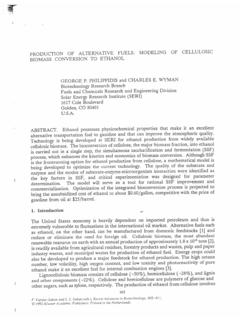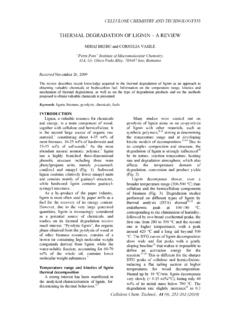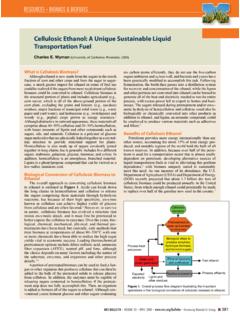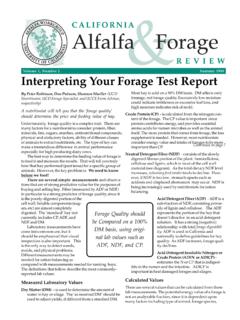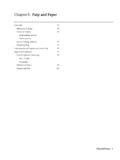Transcription of Relative Feed Value (RFV) vs. Relative Forage …
1 Relative Feed Value (RFV) vs. Relative Forage quality (RFQ) Ralph Ward Cumberland Valley Analytical Services, Inc., Hagerstown, MD Mary Beth de Ondarza, Paradox Nutrition, LLC, West Chazy, NY February 14, 2008 For buying and selling hay, it is often helpful to have one number to describe different hays rather than trying to compare full nutrient analyses profiles. Relative Feed Value (RFV) was developed a number of years ago for this purpose. The Relative Forage quality (RFQ) index was developed more recently using in vitro fiber digestibility to try to more adequately compare forages. Neither measure is used by nutritionists to develop rations. Neither RFV or RFQ should be used for corn silage because they don t reflect starch availability. Relative Feed Value (RFV) RFV is intended to reflect how well an animal will eat and digest a particular Forage if it is fed as the only source of energy.
2 Relative Feed Value is calculated from ADF and NDF content of a Forage . Dry matter intake (DMI) as a percentage of animal body weight is predicted based on the analyzed NDF content of the Forage . Digestible dry matter (DDM) (%DM) is predicted from the analyzed ADF content of the Forage . These two estimates are multiplied together and divided by the constant, , to come up with RFV. Full bloom alfalfa (41% ADF and 53% NDF) is estimated to have an RFV of 100. If a Forage has an RFV Value greater than 100, it should result in greater intake of digestible dry matter by the cow than full bloom alfalfa. RFV is calculated as follows: RFV = (DMI, % of body weight) * (DDM, % of DM) / Where: DMI = dry matter intake (% of body weight) = 120 / (NDF, %DM) DDM = digestible dry matter = ( x ADF, %DM) Dairy producers know that two forages with the same RFV don t always perform the same.
3 The RFV formula is simplistic in ranking a Forage for quality purposes, using only ADF and NDF. It works somewhat well for comparing pure alfalfas but cannot be used to compare alfalfa to alfalfa-grass or pure grass. The index does not address other nutrients such as crude protein that significantly impact quality . RFV does not consider fiber digestibility. It therefore discriminates against forages with highly digestible fiber. Haycrop Forage containing grass is underrated by the RFV system because grass contains more NDF but that NDF is more digestible than it is in alfalfa. Fiber Digestibility Highly digestible fiber improves rumen health and production primarily by increasing dry matter intake. Neutral Detergent Fiber (NDF) includes hemicellulose as well as cellulose and lignin.
4 Lignin is indigestible while cellulose and hemicellulose vary in digestibility. Cellulose is typically more slowly digestible than hemicellulose. Legumes have less total NDF but due to greater lignification, generally have lower NDF digestibility. Grasses, including corn silage, have less lignin and large ranges in maturity contributing to a large range in NDF digestibility. As plants mature, fiber content increases and NDF digestibility decreases. Cooler weather promotes NDF digestibility. High corn plant density reduces NDF digestibility. Plant genetics also influences NDF digestibility, most notably with brown midrib corn. In the past, many nutritionists predicted intake as a function of the NDF content of the ration. High fiber forages pass out of the rumen slowly, making the animal feel fuller for longer and reducing intake.
5 Mertens (1973) found that the correlation between cell wall content (NDF) and intake of sheep was His later work indicated that cows consume about of their body weight per day as NDF when rumen fill limits intake (Mertens, 1987). Now we know that rumen fill and intake are also affected by the digestibility of the Forage NDF. Researchers at Michigan State University initially analyzed data from 13 Forage studies reported in the literature (Oba and Allen, 1999). They showed that increasing in vitro or in situ NDF digestibility of ration Forage by one percentage point boosted dry matter intake by pound and pushed up 4% fat-corrected milk production by pound in dairy cows. Oba and Allen (2005) reviewed data from 12 more recent Forage comparisons reported in the literature and found that dry matter intake increased by pounds/cow/day and 4% fat-corrected milk production increased by pounds/cow/day for every one point improvement in in vitro Forage NDF digestibility.
6 These two different datasets showed very similar responses to fiber digestibility. Since the digestibility of NDF is poorly related to other nutrient concentrations in a Forage (Oba and Allen, 2005), it needs to be independently measured. An estimate of NDF digestibility can be obtained by in vitro laboratory procedures using microbes taken from the rumen of a fistulated cow or by in situ procedures where Forage samples are hung in dacron bags inside the rumen of a fistulated cow. Near infrared spectroscopy (NIRS) can be used for estimating NDF digestibility. Correlations between 30-hour in vitro NDF digestibility (% NDF) with NDF (%DM), ADF (%DM) and lignin (% NDF) (Adapted from Oba and Allen, 2005) (Data from Cumberland Valley Analytical Services, Hagerstown, MD) No.
7 Samples NDF (%DM) ADF (%DM) Lignin (%NDF) Legume 1864 Mixed mostly legume 466 Mixed mostly grass 501 Grass 93 Corn Silage 5338 Relative Forage quality (RFQ) RFQ is an estimate of how much available energy a non-lactating animal will obtain daily from a particular Forage if it is all that is fed. Relative Forage quality (RFQ) attempts to improve on RFV by using TDN (Total Digestible Nutrients) instead of DDM and calculating TDN and intake using in vitro fiber digestibility estimates.
8 RFQ should therefore do a better job than RFV of describing the production potential of a Forage . RFQ is calculated as follows (Undersander and Moore, 2002): RFQ = (DMI, % of BW) * (TDN, % of DM) / LEGUMES: (alfalfa, clovers and legume/grass mixtures) DMIL egume = 120/NDF + (NDFD 45) * .374 / 1350 * 100 TDNlegume= (NFC*.98) + (CP*.93) + (FA*.97* ) + (NDFn * (NDFD/100)) 7 GRASSES: (warm and cool season grasses) TDNgrass = (NFC*.98) + (CP*.87) + (FA*.97* ) + (NDFn*NDFDp/100) 10 DMIG rass = + *CP *CP2 - *TDN + *TDN2 + *ADF - *ADF2 - *CP*ADF Where: CP = crude protein (% of DM) EE = ether extract (% of DM) FA = fatty acids (% of DM) = ether extract - 1 NDF = neutral detergent fiber (% of DM) NDFCP = neutral detergent fiber crude protein NDFn = nitrogen free NDF = NDF NDFCP, else estimated as NDFn = NDF*.
9 93 NDFD = 48-hour in vitro NDF digestibility (% of NDF) NFC = non fibrous carbohydrate (% of DM) = 100 (NDFn + CP + EE + ash) NDFDp = + .664*NDFD Comparison Between RFV and RFQ The RFQ equation is designed so that the RFQ Index for an average quality alfalfa should generate an index Value similar to the RFV. RFQ was designed to have a similar mean and range of values as RFV. The RFQ Value will run higher or lower than the corresponding RFV index based on the NSC, NDF, and NDF digestibility of the sample. As a hay-crop material includes more grass with generally higher NDF digestibility, the RFQ will show an advantage to the Forage over the RFV. It is recommended that RFQ be used when the two values are different. Values determined at Cumberland Valley Analytical Services on hay-crop materials are as follows: Feed Type RFV RFQ Alfalfa: 145 144 Mixed: 115 129 Grass: 95 117 Shaver (2004) compared RFV and RFQ values across Forage types.
10 The equation which described the data was as follows: RFQ= (RFV) + This was almost a 1:1 relationship. However, the R-square Value of only revealed that there was a lot of scatter in the data around this line. It was difficult to predict RFQ from RFV and samples with an RFV of 140 had RFQ values ranging from 110 to 170. This makes sense because the RFQ estimates incorporate fiber digestibility which accounts for a great deal of the variation in Forage quality not accounted for by RFV. We used data from samples sent into Cumberland Valley Analytical Services to predict RFQ from RFV by Forage type. With legumes, RFV and RFQ values were very close (RFQ = (RFV) ) with this line describing the data about 79% of the time (R2= ). With mixed forages, it became more difficult to predict RFQ from RFV (R2= ) and RFQ was generally higher than RFV (RFQ= (RFV) ).


